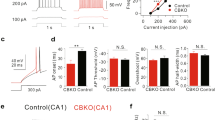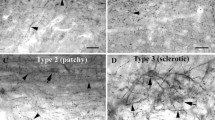Summary
Nerve cells that lack the cytoplasmic Ca2+ binding protein Calbindin-D28K (CaBP) appear to be selectively vulnerable to Ca2+-related injury consistent with a postulated intraneuronal Ca2+-buffering role of CaBP. We have confirmed the selective loss of CaBP from the dentate gyrus during kindling-induced epilepsy in acutely dissociated granule cells (GCs) from kindled rats. Immunohistochemically stained kindled neurons showed a significant loss of CaBP when compared to controls (p < 0.001; ANOVA). The Ca2+-buffering role of CaBP was assessed in acutely dissociated control and kindled GCs by examining a physiological process highly sensitive to intracellular Ca2+-buffering: the Ca2+ -dependent inactivation of high-voltage activated (HVA or L-type) Ca2+ currents in the absence (or presence) of exogenous Ca2+-chelators. Whole-cell patch clamp recordings in kindled GCs demonstrated a markedly enhanced Ca2+-dependent inactivation of Ca2+-currents. After brief conditioning Ca2+ currents, in the absence of an exogenous intraneuronal Ca2+-chelator, subsequent test Ca2+ currents were inactivated by 58.3% in kindled GCs, a significant increase from the 37.4% inactivation observed in control GCs (p< 0.005; ANOVA). The differential Ca2+ current decay and Ca2+-dependent inactivation were prevented in both control and kindled GCs upon loading the neurons with the exogenous Ca2+-chelator BAPTA. These experiments demonstrate a high correlation between the loss of CaBP and changes in Ca2+ current inactivation and are consistent with the hypothesis that CaBP contributes to the physiological Ca2+-buffering in mammalian neurons.
Similar content being viewed by others
References
Ashcroft FM, Stanfield PR (1981) Calcium dependence of the inactivation of calcium currents in skeletal muscle fibers of an insect. Science 213:224–226
Baimbridge KG, Miller JJ (1982) Immunohistochemical localization of calcium-binding protein in the cerebellum, hippocampal formation and olfactory bulb of the rat. Brain Res 245:223–229
Baimbridge KG, Miller JJ (1984) Hippocampal calcium-binding protein during commissural kindling-induced epileptogenesis: progressive decline and effects of anticonvulsants. Brain Res 324:85–90
Baimbridge KG, Mody I, Miller JJ (1985) Reduction of rat hippocampal calcium-binding protein following commissural, amygdala, septal, perforant path and olfactory bulb kindling. Epilepsia 26:460–465
Blaustein MP (1988) Calcium transport and buffering in neurons. Trends Neurosci 11:438–443
Brehm P, Eckert R (1978) Calcium entry leads to inactivation of calcium channel in Paramecium. Science 202:1203–1206
Carbone E, Lux HD (1984) A low-voltage activated fully inactivating calcium channel in vertebrate sensory neurons. Nature 310:501–503
Celio MR (1986) Parvalbumin in most gamma-aminobutyric acidcontaining neurons of the rat cerebral cortex. Science 231:995–997
Celio MR (1990) Calbindin-D28K and parvalbumin in the rat nervous system. Neuroscience 35:375–475
Coulter DA, Huguenard JR, Prince DA (1989) Calcium currents in rat thalamocortical relay neurones: kinetic properties of the transient, low-threshold current. J Physiol 414:587–604
Eckert R, Tillotson D (1981) Calcium-mediated inactivation of the calcium conductance in caesium-loaded giant neurones of Aplysia californica. J Physiol 314:265–280
Eckert R, Ewald D (1982) Residual calcium ions depress activation of calcium-dependent current. Science 216:730–733
Eckert R, Chad JE (1984) Inactivation of calcium channels. Prog Biophys Molec Biol 44:215–267
Fenwick EM, Marty A, Neher E (1982) Sodium and calcium channels in bovine chromaffin cells. J Physiol 331:599–635
Fox AP, Nowycky MC, Tsien RW (1987) Kinetic and pharmacological properties distinguishing three types of calcium currents in chick sensory neurones. J Physiol 394:149–172
Goddard GV (1967) Development of epileptic seizures through brain stimulation at low intensity. Nature 214:1020–1021
Hagiwara S, Nakajima S (1966) Effect of intracellular Ca ion concentration upon the excitability of the muscle fiber membrane of a barnacle. J Gen Physiol 49:807–818
Hamill OP, Marty A, Neher E, Sakmann B, Sigworth FJ (1981)Improved patch-clamp techniques for high-resolution current recordings from cells and cell-free membrane patches. Pflüger's Arch 391:85–100
Ichimiya Y, Emson PC, Mountjoy CQ, Lawson DE, Heizmann CW (1988) Loss of calbindin-D28K immunoreactive neurones from the cortex in Alzheimer-type dementia. Brain Res 475:156–159
Jande SS, Maler L, Lawson DE (1981) Immunohistochemical mapping of vitamin D-dependent calcium-binding protein in brain. Nature 294:765–767
Klee CB, Crouch TH, Richman PG (1980) Calmodulin. Ann Rev Biochem 49:489–515
Kostyuk PG, Krishtal OA (1977) Effects of calcium and calcium-chelating agents on the inward and outward current in the membrane of mollusc neurones. J Physiol 270:569–580
McBurney RN, Neering IR (1987) Neuronal calcium homeostasis. Trends Neurosci 10:164–169
McLachlan DR, Wong L, Bergeron C, Baimbridge KG (1987)Calmodulin and calbindin-D28K in Alzheimer disease. Alzheimer Dis Assoc Disord 1:171–179
McNamara JO (1986) Kindling model of epilepsy. In: Delgado-Escueta AV, Ward AA, Woodbury DM, Porter RJ (eds) Basic mechanisms of the epilepsies: molecular and cellular approaches. Advances in neurology, Vol 44. Raven Press, New York, pp 303–318
Miller JJ, Baimbridge KG (1983) Biochemical and immunohistochemical correlates of kindling-induced epilepsy: role of calcium binding protein. Brain Res 278:322–326
Miller JJ, Mody I, Baimbridge KG (1986) Calcium regulation in kindling-induced epilepsy. In: Wada JA (eds) Kindling, Vol 3. Raven Press, New York, pp 301–314
Mody I, Reynolds JN, Salter MW, Carlen PL, MacDonald JF (1990) Kindling induced epilepsy alters calcium currents in granule cells of rat hippocampal slices. Brain Res 531:88–94
Mody I, Salter MW, MacDonald JF (1989) Whole-cell voltageclamp recordings in granule cells acutely isolated from hippocampal slices of adult or aged rats. Neurosci Lett 93:70–75
Mody I, Stanton PK, Heinemann U (1988) Activation of N-methyl-D-aspartate receptors parallels changes in cellular and synaptic properties of dentate gyrus granule cells after kindling. J Neurophysiol 59:1033–1054
Morad M, Davies NW, Kaplan JH, Lux HD (1988) Inactivation and block of calcium channels by photo-released Ca2+ in dorsal root ganglion neurons. Science 241:842–844
Oliver MW, Miller JJ (1985) Alterations of inhibitory processes in the dentate gyrus following kindling-induced epilepsy. 57:443–447
Pusch M, Neher E (1988) Rates of diffusional exchange between small cells and measuring patch pipette. Pflüger's Arch 411:204–211
Racine R (1972) Modification of seizure activity by electrical stimulation. II. Motor seizure. Electroencephal Clin Neurophysiol 32:281–294
Rogers J (1989) Calcium-binding-proteins: the search for functions (news). Nature 339:661–662
Roth J, Baetens D, Norman AW, Garcia-Segura LM (1981) Specific neurons in chick central nervous system stain with an antibody against intestinal vitamin D-dependent calcium binding protein. Brain Res 222:452–457
Scharfman HE, Schwartzkroin PA (1989) Protection of dentate hilar cells from prolonged stimulation by intracellular calcium chelation. Science 246:257–260
Schulman H (1988) The multifunctional Ca2+/Calmodulin-dependent protein kinase. Sec Messenger Phosphoprot Res 22:39–112
Seto-Ohshima A, Lawson DE, Emson PC, Mountjoy CQ, Carrasco LH (1988) Loss of matrix calcium binding protein containing neurons in Huntington's disease. Lancet 1:1252–1255
Sloviter RS (1989) Calcium-binding protein (calbindin-D28K) and parvalbumin immunocytochemistry: localization in the rat hippocampus with specific reference to the selective vulnerability of hippocampal neurons to seizure activity. J Comp Neurol 280:183–196
Sloviter RS, Barbaro NM, Laxer KD (1989) Calcium-binding protein (calbindin) and parvalbumin-like immunoreactivity (LI) in the “normal” and “epileptic” human hippocampus. Epilepsia30:719
Stoclet JC, Gerard D, Kilhoffer MC, Lugnier C, Miller R, Schaeffer P (1987) Calmodulin and its role in intracellular calcium regulation. Prog Neurobiol 29:321–364
Sutula T, Xiao-Xian H, Cavazos J, Scott G (1988) Synaptic reorganization in the hippocampus induced by abnormal functional activity. Science 239:1147–1150
Tillotson D (1979) Inactivation of Ca conductance dependent on entry of Ca ions in molluscan neurons. Proc Nat Acad Sci USA 76:1497–1500
Trends Neurosci (1989) Special issue — calcium-effector mechanisms. Trends Neurosci 12:417–478
Tsien RY (1980) New calcium indicators and buffers with high selectivity against magnesium and protons. Biochem 19:2396–2404
Tuff LP, Racine RJ, Adamec R (1983) The effects of kindling on GABA-mediated inhibition in the dentate gyrus of the rat. I. Paired pulse depression. Brain Res 277:79–90
Wassermann RH, Taylor AN (1966) Vitamin D3-induced calcium binding protein in chick intestinal mucosa. Science 152:791–793
Yeh GC, Bonhaus DW, Nadler JV, McNamara JO (1989) N-methyl-D-aspartate receptor plasticity in kindling: Quantitative and qualitative alterations in the N-methyl-D-aspartate receptor-channel complex. Proc Natl Acad Sci 86:8157–8160
Zar JR (1984) Biostatistical analysis. Prentice-Hall Inc, New Jersey
Author information
Authors and Affiliations
Rights and permissions
About this article
Cite this article
Köhr, G., Lambert, C.E. & Mody, I. Calbindin-D28K (CaBP) levels and calcium currents in acutely dissociated epileptic neurons. Exp Brain Res 85, 543–551 (1991). https://doi.org/10.1007/BF00231738
Received:
Accepted:
Issue Date:
DOI: https://doi.org/10.1007/BF00231738




